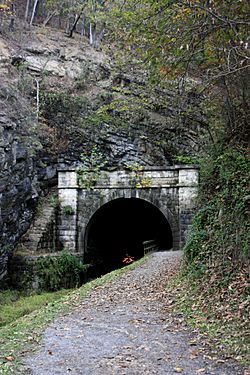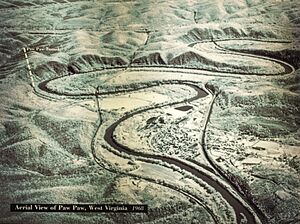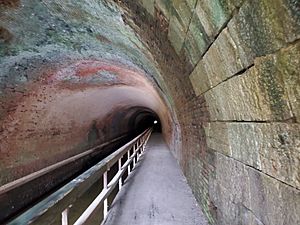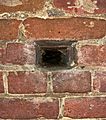Paw Paw Tunnel facts for kids
 |
|
| Tunnel entrance | |
| Overview | |
|---|---|
| Location | Allegany County, Maryland |
| Coordinates | 39°33′20″N 78°27′46″W / 39.555556°N 78.462778°W |
| Operation | |
| Work begun | June 1836 |
| Owner | National Park Service |
| Traffic | Canal and towpath/trail |
| Character | Boats, pedestrians, bicycles, horses |
| Technical | |
| Length | 3,118 feet (950 m) |
| Tunnel clearance | 24 feet (7.3 m) |
| Width | 27 feet (8.2 m) |
The Paw Paw Tunnel is a long canal tunnel in Allegany County, Maryland. It is about 3,118 feet (950 m) long. This tunnel is part of the famous Chesapeake and Ohio Canal (C&O). It was built to help canal boats avoid a tricky part of the Potomac River. This part had five sharp, horseshoe-shaped bends. The tunnel is named after the pawpaw trees that grow nearby.
Many people consider the Paw Paw Tunnel a true engineering wonder. It used over six million bricks to build! The tunnel helped make the nearby city of Cumberland, Maryland, more successful. It cut out about six miles of the canal route.
Work on the tunnel started in 1836. People thought it would be done in just two years. They also expected it to cost only $33,500. But the project turned out to be much harder and more expensive. The tunnel finally opened in 1850, more than ten years late.
The project faced many problems. The builders didn't realize how difficult the work would be. Also, workers from different countries sometimes fought. The company building the tunnel often had money problems. This meant workers didn't always get paid on time. By the time it was finished, the tunnel cost about $600,000. This huge cost almost caused the Chesapeake and Ohio Canal Company to go broke. Because of the high cost and long delays, the canal ended at Cumberland, Maryland. It never reached its original goal of going all the way to Pittsburgh.
Canal boats used the tunnel until the C&O Canal closed in 1924. Today, the tunnel and its walking path are open to the public. They are part of the Chesapeake and Ohio Canal National Historical Park. The Paw Paw Tunnel might not be the longest tunnel in the world. But it was a huge achievement for its time.
Contents
Building the Tunnel: A Big Challenge
Engineers planning the canal faced a big problem at Paw Paw. The river here had steep cliffs on the Maryland side. They could either follow the winding river, which would be very difficult. Or they could build a tunnel straight through the land. A new engineer, Charles B. Fisk, convinced everyone that a tunnel was the best idea. The plan for the tunnel was approved in February 1836. They hoped to finish it by July 1838.
Lee Montgomery got the contract to build the tunnel in March 1836. He had experience from building another canal tunnel. Construction began that same year. However, the Irish workers he hired were not skilled at digging tunnels. So, he brought in skilled miners from England and Wales. He also hired German laborers. This mix of workers led to serious problems.
Worker Conflicts and Delays
There were many fights among the different groups of workers. These fights broke out in 1837 and 1838. Irish workers often clashed with other groups. They even destroyed buildings and burned down worker shacks. More riots happened in 1839. Despite these problems, Montgomery managed to dig through the tunnel on June 5, 1840. He dug about 1,505 feet (459 m) from the south end. But he couldn't finish the whole project.
Work on the tunnel stopped completely from 1841 to 1847. This was due to both construction and money problems. In 1848, a new company, McCulloch and Day, took over. They finished the tunnel. It opened for boats in 1850. The brick lining inside the tunnel was completed after it opened. The final cost was much higher than planned. It ended up costing over $616,000. In 1872, a special signal system was added. This helped control boat traffic through the tunnel.
Life for Boatmen in the Tunnel
Boatmen on the canal had ways to tell if another boat was in the tunnel. The water level inside would drop about 4 inches (10 cm). Boats going downstream (with the current) were supposed to have the right of way. But this rule was often ignored. Sometimes, boatmen would even get into fights over who went first.
The tunnel was very narrow. There wasn't enough room to walk between the mules pulling the boats and the tunnel wall. Passengers sometimes played music or sang inside the tunnel. They loved to hear the echoes. It also helped them feel braver in the dark tunnel.
The Tunnel Today
Today, you can easily explore the Paw Paw Tunnel. Just bring a flashlight! The old towpath, where the mules walked, is still there. You can walk through the tunnel and come back the same way. Or, you can hike back over the 2-mile-long (3.2 km) Tunnel Hill Trail. This trail has signs that tell you about the German and Irish workers. They lived along this path while building the tunnel.
In January 2013, a rockslide closed the trail east of the tunnel for four months. This meant you couldn't reach the tunnel from that side. It reopened on April 17, 2013.
The National Park Service (NPS) started a project in 2017. They are fixing loose rocks near the tunnel entrance. The first part of this project is done. It fixed the most dangerous sections. The second part began in May 2019. It will fix more areas downstream. This project costs about $750,000.
Images for kids










